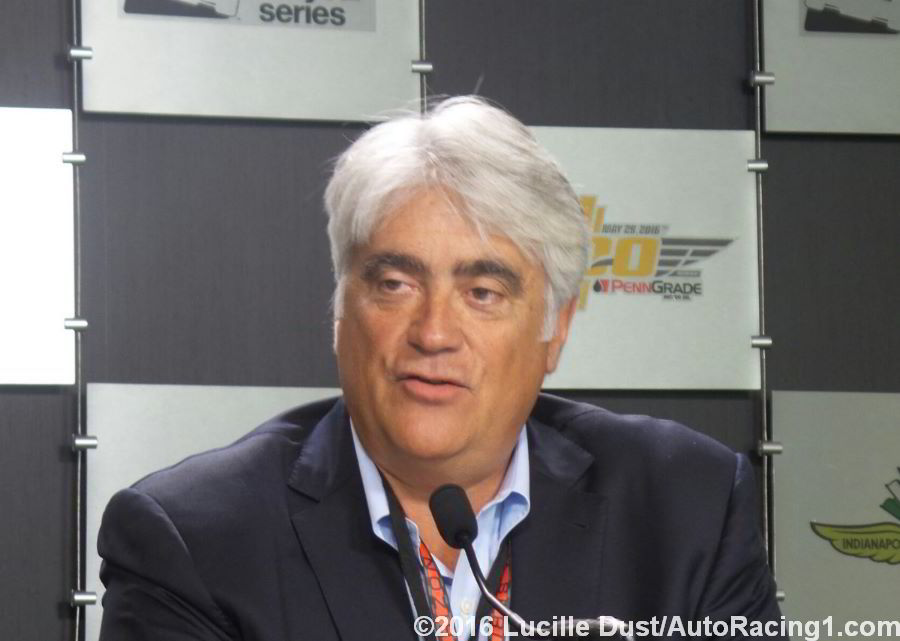IndyCar CEO doesn’t see a cap to its growth
 |
| Mark Miles sees a bright future ahead for IndyCar |
The 100th Indianapolis 500 did such an extraordinary box office last year, drawing the first sellout in race history with an estimated crowd of 350,000, that race officials understood that it would be virtually impossible to match ticket sales for the 101st race on May 28 writes Dave Caldwell of the NY Times
Mark Miles, the chief executive for Hulman & Company, which owns Indianapolis Motor Speedway and the IndyCar Series, set a more modest benchmark: Get half of the 130,000 increase in attendance between the 2015 and 2016 races to return in 2017.
A crowd of about 275,000 would serve as another key metric for the famous race, and the open-wheel series in general. Nearly three months before the Indy 500, Miles said in an interview this week that attendance is expected to be in that vicinity.
As a result, Miles said of the series, “I don’t see any cap to our growth."
He was speaking by telephone from St. Petersburg, Fla., where the IndyCar Series will open Sunday with a race on a temporary street course. The schedule has been expanded to 17 races from 16, with an Aug. 26 event added at Gateway Motorsports Park in Madison, Ill., outside St. Louis.
All 16 races that were held last year will return in 2017, Miles said, and all of this year’s races are expected to return next year — a sign of continuity for a series that took a hit last year when promoters abruptly dropped plans for a race on the streets of Boston on Labor Day weekend.
Its recent struggles with attendance and television ratings notwithstanding, Nascar remains the king of racing in the United States. But IndyCar racing, with sleek open-wheeled racers that can turn 220-mile-per-hour laps, appears to have established a foothold after spinning for two decades.
 |
| A record 350,000 attended last year's Indy 500 |
Miles said six events in 2016 bettered or matched previous attendance records. TV ratings are up by 55 percent in the last three years, with an increase in each of those seasons.
“The relationship between team owners and the sanctioning body has never been better than it is today," said Bobby Rahal, the 1986 Indianapolis 500 winner who owns a team in the series.
Rahal laughed and quickly added, “And that hasn’t always been the case."
Sponsors seem to like that the series has promoted events as more than places to watch races. Philip Dobbs, the chief marketing officer for Bridgestone Americas Tire Operations, said the company extended its contract for Firestone to serve as the series’ tire supplier to 2020, in part, because race weekends often include concerts with top musicians.
Bridgestone takes hundreds of customers to the Indy 500, for example, and they often are stunned at how visceral and compelling the race weekend is.
“It’s all about the racing," Dobbs said, “but there are other things that make it an experience."
After focusing its marketing efforts in the last three years on reclaiming lapsed IndyCar fans 45 and older, the series has begun a campaign to draw younger fans, a challenge for all motorsports organizations.
During an interview in New York last month, the veteran Nascar driver Dale Earnhardt Jr. said of stock-car fans: “Average age is going up, up, up, up. We have the same fans we’ve always had, but we’re not getting younger fans. Why don’t they like what we’re doing? Why is this not grabbing them and bringing them to the racetrack, or tune in? We got to figure it out."
C. J. O’Donnell, the chief marketing officer at Hulman Motorsports, said that the IndyCar Series, like Nascar a few years ago, has started shifting its marketing focus away from print and TV advertising and toward digital and social media.
O’Donnell said that younger potential fans seem to like the technology of Indy cars, the American and international drivers — and, interestingly, road courses like those at St. Petersburg and Long Beach, Calif., over traditional ovals like Indianapolis. The speed of the cars is alluring.
“First and foremost, it’s fast," O’Donnell said. “It doesn’t really take an adept race fan to realize that we’re going a lot faster than our friends down South."
The series sells its speed through technology. For instance, Rahal pointed to the response his 28-year-old son, Graham, a 10-year veteran on the IndyCar Series, drew when he posted a video of him taking practice laps last month wearing a so-called visor cam.
Graham Rahal put the video on Twitter, and it was posted online at the IndyCar website, the Men’s Health magazine site and YouTube. Some viewers thought it was a simulation of a video game.
“It’s that kind of stuff that brings people in," Bobby Rahal said. “People look at it and think, ‘Holy smokes, this is something else.’"
Next season, the series will unveil a new racecar design, which IndyCar officials offered a sneak peek of at the North American International Auto Show in Detroit in January.
Rahal also noted the influx of IndyCar drivers in their early to mid-20s as a selling point.
The 100th Indy 500 was won by the 25-year-old Californian Alexander Rossi. It was an aesthetic and financial success, but as O’Donnell said, “It’s not just one inning — it’s a game here."
He added, “We’re ascending again as a sport."
The public squabbles that cleaved open-wheel racing in the late 1990s and early 2000s feel almost like ancient history to those who were involved, and the goal now is for the series to pull away as quickly as it can. Having cars that go really fast will come in handy.
Speaking about what the series is trying to sell, Miles said: “You can think of it as speed, but sometimes I think of it as adrenaline. It is adrenaline packed." Dave Caldwell/NY Times
